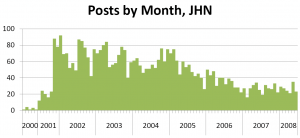It’s hot here in Burlington, MA, pushing 98, but it must be even hotter in the Moscone Center with the liveblogging that’s going on right now. I’ve been looking at Engadget, CNet, Gizmodo, and TechCrunch for the updates. So far TechCrunch is up and down like a drunken sailor and Gizmodo is the fastest and most responsive.
News so far: there will be a 10.6 called “Snow Leopard,” and Steve’s gonna update him some iPhone.
iPhone points of interest: reiterating the enterprise features announced when the SDK was announced, including Exchange support, native Cisco integration. I note that all the liveblogging sources describe these as features of the iPhone 2.0 software, not the iPhone 2.0 itself; this holds out hope that my 1st gen model is good for at least one upgrade.
The SDK demo includes a feature called Core Location. I don’t even want to think how many business plans in my entrepreneurship class at Sloan back in 2001 imagined a similar feature for mobile phones, breathless with the knowledge that the government was going to require carriers to be able to triangulate handsets down to a few hundred meters to support 911 calls. Mobile dating service…on your handset! With…. contextually relevant ads!!!$! Maybe this iteration will give us some more imaginative apps for location technology.
I love that Sega is the first ISV to demo an app here. Again: iPhone is mobile gaming platform.
eBay mobile client: yawn. Facebook and Bloglines made more impressive mobile apps just by working in the browser, guys. You had 95 days on the SDK and this is all you could build?
Loopt demo. Regarding my note above… no, not really, unless you count integration with Google maps.
The TypePad client looks interesting. Wonder if it’ll work with WordPress?
The AP iPhone client is kind of brilliant in a way nothing else here is–because it not only sends down AP content, it allows you to send it up! Crowdsourcing the news at its finest.
I kind of like the piano simulator from Moo Cow Music. Their site is down but there’s a YouTube video of their demo (thanks, Google Cache).
(All these demos, btw, are called “demonstrating momentum.” I’m waiting for them to trot out that SalesForce demo again just to drive the point home to Wall Street.)
First new feature: central (Apple provided) push notification for all background apps. How well will that scale if Apple can’t even keep Webmail for .Mac running? Saying “it’ll scale” without details is a little sketchy in the post-Twitter world.
Free update for current iPhone owners = good.

